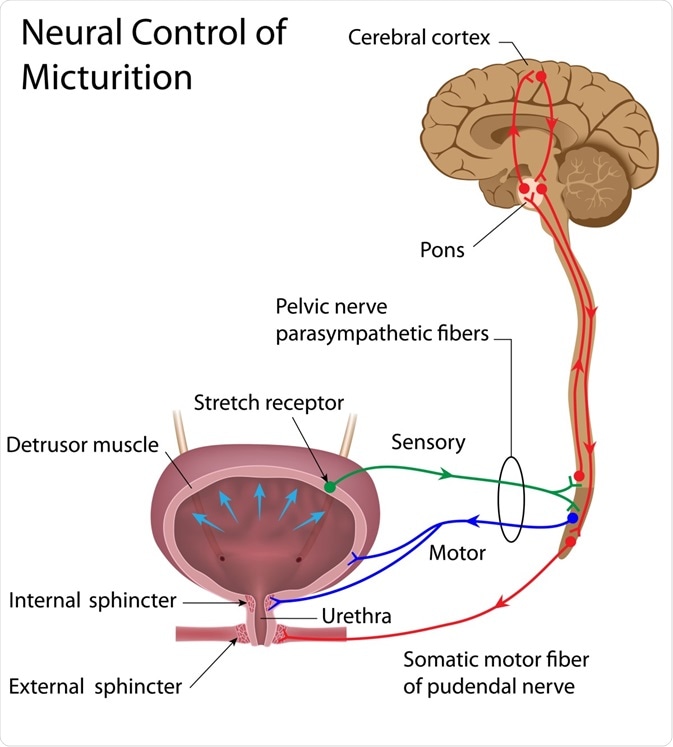Micturition or urination is the process of emptying urine from the storage organ, namely, the urinary bladder. The detrusor is the smooth or involuntary muscle of the bladder wall. The urethral muscles consist of the external and internal sphincter. The internal sphincter and detrusor muscle are both under autonomic control. The external sphincter, however, is a voluntary muscle under the control of voluntary nerves.
The bladder normally accommodates up to 300-400 ml in adults. When the bladder is distended it sends signals to the brain, which is perceived as the 'full bladder' sensation.
The process of emptying the urine into the urethra is regulated by nervous signals, both from the somatic and the autonomic nervous system. The autonomic nervous system comprises both the sympathetic and the parasympathetic nervous system.
The bladder has two states of function; the storage and emptying phases.

Image Credit: Alila Medical Media / Shutterstock
Bladder Filling and the Guarding Reflex
The filling phase is characterized by voluntary contraction of the external urethral sphincter, with sympathetic contraction of the inner urethral sphincter. The sympathetic nervous system also enables the detrusor to distend without reflex contractions, unlike that which happens in most voluntary muscles.
Urethral reflexes, called ‘the guarding reflex,’ also play a part in inhibiting involuntary bladder emptying during this process. The afferents are all conveyed through the pelvic nerves to initiate a spinal reflex.
Bladder Emptying and the Micturition Reflex
The micturition or emptying phase displays a coordinated relaxation of the inner and outer urethral sphincters, under sympathetic and somatic regulation respectively, with strong contractions of the detrusor muscle due to parasympathetic impulses.
Micturition is thus characterized by:
- relaxation of the striated sphincter (somatic innervation)
- relaxation of the smooth muscle sphincter and opening of the bladder neck (sympathetic innervation)
- detrusor contraction (parasympathetic innervation)
The distension of the urinary bladder wall causes wall tension to rise very slightly. However, when the bladder is almost full, at about 300-400 ml, the inherent contractility of the detrusor causes reflex contractions to occur, which are less powerful than the voiding contraction. Afferent firing frequency increases with filling, but cortical control still overrides the micturition reflex until voluntary voiding is determined upon.
During micturition, urinary flow is assisted by additional detrusor contractions and external sphincter relaxation which further lowers resistance to the passage of urine. The abdominal wall and pelvic floor musculature also participates by increasing the force on the bladder to help achieve complete emptying.
Spinal Reflex Arcs
The act of micturition is an autonomic reflex at the level of the spinal cord. This reflex also helps to complete micturition when the act is voluntarily initiated, or when it follows a period of inhibition by the brain, by relaxing the external sphincter.
The control of this process is mediated via afferent signals from stretch and volume receptors in the bladder, as well as from the muscles of the pelvic floor, the vagina/penis, and the rectum, which informs the brain about the extent of filling, initiating several spinal reflexes. These serve to inhibit micturition until filling is complete while activating the voluntary external urethral sphincter via the pudendal nerve. At the same time, detrusor activity is inhibited and the internal urethral sphincter is stimulated via sympathetic activity. Impulses from the filling bladder are carried to the spinal cord via the pelvic and hypogastric nerves, whereas the pudendal and hypogastric nerves carry impulses from the neck of the bladder and the urethra.
Pontine Micturition Center
The pontine micturition center (PMC) in the brainstem is activated via afferent signals from the urinary bladder as it is filling. This center sends inhibitory impulses to the spinal reflex arcs to enable bladder voiding.
In the absence of any other regulation, the afferents from the bladder and urethra to the midbrain and pons and the efferents to the spinal cord would act as an on-off switch, to cause either reflex voiding or storage depending only on the urine volume stored in the bladder. This means that during the filling or storage phase, the voiding reflex is off, but it is switched on to the highest level when the bladder is distended beyond a critical point, activating the tension receptors in the wall.
Central Nervous System Regulation
As the bladder fills, the conscious sensation is perceived and the cortical signals are triggered. This inhibits the purely involuntary firing of the voiding reflex and instead helps the individual to control voiding until the time and place are appropriate. This includes social, sensory, and emotional states, including the degree to which bladder stretching is sensed to be safe and tolerable. The cell group in the periaqueductal gray (PAG) plays a role in detecting the bladder distension, as well as in relaying bladder afferents to higher centers in the brain and enabling the person to feel the sensation. It also regulates the feed to the pontine center, while receiving afferents from higher brain centers such as the anterior cingulate and the prefrontal cortex. These help to inhibit the voiding reflex via suppression of PMC excitation.
The PMC neurons are released from inhibition and fire maximally once the voluntary signal for voiding is produced. This causes excitation of the sacral neurons which stimulate detrusor contractions and induce a sudden increase in turn of intravesical pressure, as well as relaxing the external or voluntary urethral sphincter. Once the intravesical pressure overcomes the urethral resistance, urine flows out through the urethra.
Micturition is thus under cortical control as well as mediated by the spinal reflex arc, which inhibits the pontine center until it is deemed appropriate to void. In addition, the motor cortex controls the voluntary muscle of the external urethral sphincter. The decision to void implies that the prefrontal cortex suppresses the tonic inhibition of the afferents from the PAG to the PMC.
Urethral Reflexes
The flow of urine and the mechanical distension of the urethra together cause detrusor contractions to occur, which encourages complete bladder emptying.
The Micturition Reflex
References
Further Reading